 Thursday - July 19, 2012
Thursday - July 19, 2012
bra and undies found in castle vault, thought to be 500 yrs old.
Whatcha think people?
I enlarged this to a point where I could hardly go any more, to try and see the threads and the stitching and I’m still not sure. The stitches could have been made by machine. (?)
Question for anyone who might know.
Is it possible to fake carbon dating? These items look .... not fake maybe. If you go to the site and enlarge the top photo and see the stitching, wouldn’t you wonder how they’d have managed to make a needle that fine to produce that kind of stitch?
Okay, if this is all for real, it’s a heck of a find and story.
Discovered in a castle vault, the scraps of lace that show lingerie in use 500 years ago
By DALYA ALBERGEIt is hardly racy by today’s standards but this skimpy lingerie has certainly shocked historians.
The lace and linen undergarments date back to hundreds of years before women’s underwear was thought to exist.
They had lain hidden in a vault beneath the floorboards of an Austrian castle since the 15th century.
Despite their state of decay, the knickers bear more than a passing resemblance to the string bikini briefs popular today, while the bra has the fitted cups and delicate straps of its modern-day counterparts.
While it was known that medieval men wore undergarments like modern-day shorts, it was thought that women simply wore a smock or chemise.
It was thought that knickers didn’t make an appearance until the late 18th century.
Bras were thought to be an even more modern invention, not appearing until around 100 years ago.
Hilary Davidson, fashion curator at the Museum of London, said the discovery ‘totally rewrites’ fashion history, adding: ‘Nothing like this has ever come up before.’
She believes it is ‘entirely probable’ that something similar was worn by Britain’s medieval women.
‘These finds are a very exciting insight into the way people dressed in the Middle Ages,’ she continued.
‘It’s rare that everyday garments of any kind survive from this period, let alone underwear.’
The undergarments were among almost 3,000 fragments of clothing and other detritus found in Lengberg Castle in East Tyrol during recent renovations.
It is thought that they were buried when the building was extended in 1480 and that the exceptionally dry conditions stopped the fragile garments from disintegrating over the centuries.
Beatrix Nutz, of Innsbruck University, who made the find, initially faced scepticism but radiocarbon-dating tests confirmed her suspicions.
The haul included four bras and two pairs of pants. Two of the bras resemble modern counterparts but the others are described rather bluntly as ‘shirts with bags’, the August issue of the BBC History Magazine reports.
Posted by peiper
Filed Under: • Amazing Science and Discoveries • Archeology / Anthropology •
• Comments (2)
 Wednesday - July 04, 2012
Wednesday - July 04, 2012
danish bog gives up the dead of 200
Woo-Hoo, take a look at this.
Every time something new crops up, well not exactly new. A new discovery of Something old. Right. That’s what I meant.
We don’t hear much from Denmark in the way of this sort of discovery, so I guess this is pretty big news.
I remember reading somewhere that Denmark was the birthplace of the Vikings. But I just never gave a lot of thought to their history outside of the Viking era.
I have cut a bit out and haven’t posted any pix. Catch those at the link.
Bones of 200 slaughtered soldiers from the time of Christ are so well preserved in peat bog that their DNA can be studiedBy EDDIE WRENN
Danish archaeologists have re-opened a mass grave of scores of slaughtered Iron Age warriors to find new clues about their fate and the bloody practices of Germanic tribes on the edge of the Roman Empire.
Bones of around 200 soldiers have already been found preserved in a peat bog near the village of Alken on Denmark’s Jutland peninsula.
Experts started digging again on Monday, saying they expected to find more bodies dating back 2,000 years to around the time of Christ.
Aarhus University archaeologist Mads Kahler Holst said: ‘I guess we will end up with a scale that is much larger than the 200 that we have at present.’
Speaking by phone from the site on damp grazing meadows near Jutland’s large lake of Mossoe, he added: ‘We have only touched upon a very small part of what we expect to be there ... We have not seen anything like this before in Denmark, but it is quite extraordinary even in a European perspective.’
The first bones, belonging to people as young as 13, were discovered in 2009.
Cuts and slashes on the skeletons showed they had died violently, said Holst. But nothing was known for sure about the identity of the killers, or their victims.
‘That is one of the big mysteries ... We don’t know if it is local or foreign - we would expect it to be local,’ Holst said.
‘We think it is a sacrifice related to warfare and probably the defeated soldiers were killed and thrown into the lake,’ he said.
The remains are so well-preserved that experts will be able to analyse their DNA - a rare achievement in remains so old, said Ejvind Hertz, curator of archaeology at Skanderborg Museum.
Preliminary DNA tests have been carried out at a laboratory on six teeth and two femur bones. ‘There was not much in the femurs but there was in the teeth - teeth are good at preserving DNA,’ Hertz said.
The DNA of people who lived at that time would not normally differ from the DNA of today’s Scandinavians. If differences are found, it could point to a foreign army from southern Europe, Hertz said.
Posted by peiper
Filed Under: • Archeology / Anthropology •
• Comments (0)
Original Art
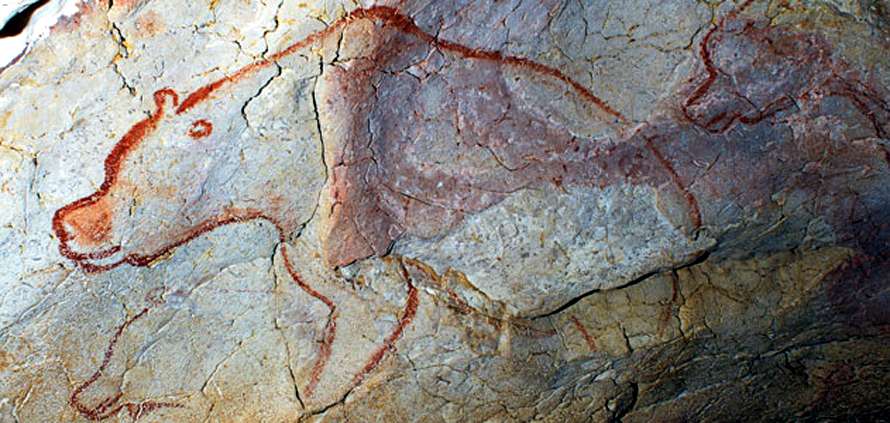
I think I’ve found my art form. Impressionism and Realism. Early Impressionism. REALLY REALLY early. I followed a link from Stoaty the Woozle to the Chauvet cave paintings in southern France. Unbelievable. Drawn by hand from colored mud. Minimalist and perfect, each line exactly right the very first time, yet the shading and nuance and interrelation with the three dimensional surface of the cave walls gives them a life of their own and nearly demands that you give the drawings far deeper meaning than just pictures of animals. Animals conveyed with a sense of motion and emotion. The cave bear painted above was one of the most fearsome mammals to ever walk the earth, yet he looks happy and nearly comical. Art of the purest form. Rendered in the dark by the rudest form of torchlight, in a cave atmosphere so high in radon and carbon dioxide that it’s nearly fatal. How’s that for suffering for your creativity?
There are hundreds of links to these cave paintings, which were only discovered in 1994. The drawings were created over a 10,000 year period, which is amazing enough right there, a period more than twice as long as our awareness of “human civilization”, yet the cave continued to be used by Ice Age lions and tigers and bears the whole time. Oh my. Then a rockfall sealed off the cave for 20,000 years and preserved the works as a natural museum. Due to the bad atmosphere and the fragility of the art works, the cave is off limits to the general public.
Mysteries from the ancient past. Creative skill levels unguessed at by anthropology. A religious shrine, a center for manhood initiation, or just the original party shack where you’d get high just being there? Far out, man, let’s tag these walls.
The Chauvet cave paintings are nearly twice as old as the more famous cave paintings in Lascaux, though they show similar creatures. Perhaps the same artist colony moved there once the first cave was sealed off. We will never know.
I’m hoping that high quality prints of some of these are available, though even the most meticulous rendition would lose most of it’s meaning when taken out of context and rendered on a flat canvas. This one is my favorite, and it’s only half of the original drawing. I have no idea how big the original is, but I’d swoon to be able to own an accurate print of it, done on pale leather to mimic the surface texture, about 5 by 8 or 12 feet. I’d hang it in an empty room, barely and indirectly lit by soft yellow orange light to weakly attempt to recreate the original illumination. The effect would be transportive, and that’s with my 21st Century arrogance and sophistication. Seeing the real one for the first time by torch light must have been mind blowing for Ugh the caveman. The birth of art and perhaps religion as well.
http://www.bradshawfoundation.com/chauvet/chauvet_cave_art.php
http://donsmaps.com/chauvetcave.html
http://ngm.nationalgeographic.com/ngm/data/2001/08/01/html/ft_20010801.6.html
http://www.edutarian.com/2011/02/cuchet-cave-and-radon-gas.html
Posted by Drew458
Filed Under: • Archeology / Anthropology • Art-Photography •
• Comments (0)
 Monday - July 02, 2012
Monday - July 02, 2012
More Than Possible; It’s Probable
A nice thought for a hot summer’s day. And while there is no proof of any positive answer to my question, it is certainly possible.
After all, the Egyptians had cows, goats, and sheep ... therefore they had milk and cream. And probably a butter churn, which is really not much more than a couple of cross boards on a stick. The same kind of design as a the paddles in an ice cream maker. They had fruit and spices for flavoring. And not only did they have honey for sweetening, they had locust beans, which are used as a thickener in ice cream today. Locust beans are also known as Carob, and Carob is a chocolate substitute for allergic folks. And dogs. Has been, since always. Vanilla beans come from Madagascar, a bit down the coast. Certainly within trading distance. The Egyptains had some really decent metal working ability, enough to make a copper or a bronze bucket. Or a solid gold one. The observation that salty ice water is colder than plain old ice water is probably as old as time, and with the north end of their country being a sea shore, they certainly had salt.
So they had everything necessary to make ice cream, from the ingredients to the machinery. “Oh no”, you say, “you’re missing the most important thing! It was Egypt. Aegypt!! Hot. Desert. Hot. Sand. Hot. Camels! Did I mention hot? They didn’t have ice!!”
Wanna bet?
See this thing?
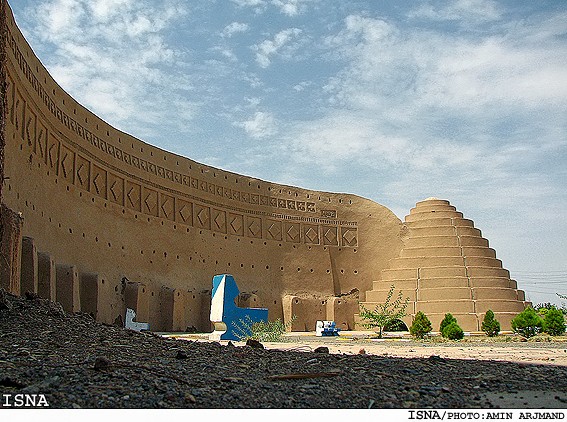
Take a guess what it is. It’s a design that dates back to ancient Persia, at least 500 BC. Maybe 1000 BC. Persia; Egypt’s neighbor and occasional conqueror, just a short reed boat ride across the Red Sea away.
So what’s this pile of stone? It’s the ultimate Green Kitchen Accessory. It’s made out of mud brick ... and it’s a giant wind powered refrigerator. An ice box, bigger than a house. One that may have had a built in ice maker, albeit one that only works at night. When it gets really cold in the desert.
I’ve got a lot of reading to do on this, but I wanted to toss the question out to give everyone something new to think about. More fun than reacting to today’s political nonsense, or tomorrow’s, or yesterday’s.
Ok Drew, how would it work?
First off: the air conditioning part. That we know existed, and still exists. Readers from the southwest will be familiar with an old form of A/C called a Swamp Cooler. Evaporative cooling. Blow hot dry air across some water and it cools right down. Take that concept and build it on a massive scale. City size. Several dozen miles long if necessary. But to get there, you’ll need water. Lots of nice, cold water. Here’s your shovel. Start digging.
If you live in a hot dry climate and you need to get water from the spring way over there to your city and farm fields over here, you don’t go and build a canal or an aqueduct. Too much evaporation. No, you build a qanat ("kwaa gnat"). That’s an underground water channel built between a spring somewhere in the mountains and a city somewhere near by. There are tens, if not hundreds, of thousands of the things across the Middle East and the Far East, from Tunisia to Iran to China. They’ve been around for about 3000 years. Most of the water in Iran is still collected this way even today. Digging a water tunnel underground is kind of difficult, so the qanat builders put in an air shaft every 100 feet or so; the lines of these shafts dimple the desert surface by the millions, mile after mile after mile.
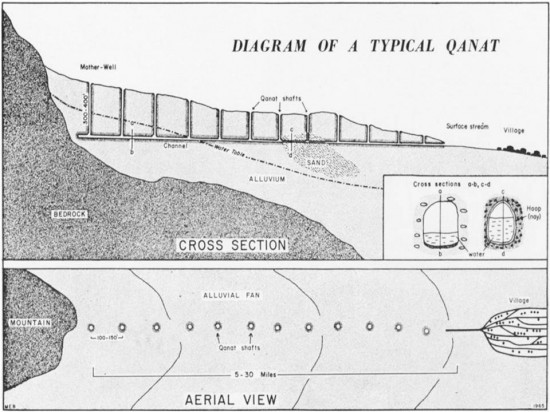
Ok, now that you’ve got you qanat built, and your village is getting water ... nice cool water too, from deep underground, but not so deep it starts getting hot again ( about 100 yards or so maximum ). Your tunnel digging slaves have finished, so you cap off the access/air shafts to the qanats. This cuts evaporation to a minimum, and keeps the stupid sheep from falling down the holes.
But you leave one air shaft open. And then you build a building over one of the last air shafts. Make it out of nice heat resistant clay brick, with walls 6 or 9 feet thick. Pretty good insulation right there. Now put a tower on top of the building, with a doorway on the leeward side. A hole in the floor on every level lets air flow from the top of the roof all the way to the basement, all the way down the air shaft, to the cool water flowing in the qanat deep underground.
Except the air doesn’t flow that way. Due to Bernoulli’s Principle, the wind blowing past the tower and past it’s door on the downwind side creates a pressure differential. A partial vacuum. This pulls in hot desert air into the open air shaft (don’t forget to put a sheep filter across it first), and pulls that air underground and across the cold flowing water in the qanat tunnel, and then up into your building. So you get a nice steady cold damp breeze blowing in from the basement. Natural air conditioning.

It works. It’s another ancient design, but largely forgotten by the West. There are lots of these in Spain that still function. You can read all about them, about how they are wonders of Islamic Science from the Golden Age of Islam ... but they aren’t much more advanced than the ones that the Persians built under Sargon I, somewhere around 1000-800 BC. The design was used by the Egyptians, the Greeks, the Romans, and even those barbarians living in Libya. Older than the Profit, may bees pee upon him. Merely copied and brought north by his minions 1000 or so years after it was invented.
Ok, back to our mud refrigerator. Anybody who understands Bernoulli’s principle and the Venturi Effect, or who owns a perfume sprayer, knows that you can pull liquid up a tube with just air flowing across the top of the pipe. See the picture of the big mud fridge and the wall next to it? It’s built above a qanat, and the air shafts run up inside the wall. Really thin ones probably. The wind blows, gets deflected over the top of the wall ... which pulls water up the narrow shafts ... which then runs in a channel near the top of the wall, just like in an aqueduct ... and then flows off the end of the wall onto the spiral stepped surface of the beehive shaped ice box, around and around, cooling the outside. The builders figured out how to make waterproof mud brick (duh, it’s called a kiln, right?), the walls are very thick and well insulated, it gets cooled from the outside by running water all day long, cooled from the inside by evaporative cooling from the subterranean qanat water, and filled with ice or snow gathered during winter. And who knows, perhaps refreshed with any ice made during those cold desert nights. So it IS a giant refrigerator, and it could be an ice maker too.
The one in the picture is about 110 years old, and was built in Sirjan, Kerman Province, in Iran by the first Shah, Pahvli I. The design however is almost as old as Persia.
So it is entirely possible that the Egyptians, always hot to copy a good new idea like the sandal and the horse and the wheel, had these things. Gone now, because even waterproof mud brick doesn’t last forever. And their king, the Pharaoh - at least the later Pharaohs, who spoke Persian or Greek - could have enjoyed a double scoop cone in his cool and moist palace. The technology existed. Mock-chocolate and vanilla flavored.
All I have to do is find some ancient Eastern version of the waffle cone, and my thesis is good to go. ![]()
Posted by Drew458
Filed Under: • Amazing Science and Discoveries • Archeology / Anthropology • Architecture •
• Comments (1)
 Wednesday - April 04, 2012
Wednesday - April 04, 2012
Biggest And Oldest Redhead Ever!
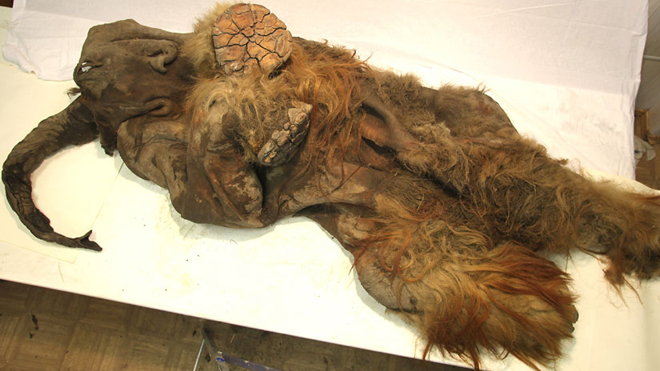
A juvenile mammoth, nicknamed “Yuka,” was found entombed in Siberian ice near the shores of the Arctic Ocean and shows signs of being cut open by ancient people.
The remarkably well preserved frozen carcass was discovered in Siberia as part of a BBC/Discovery Channel-funded expedition and is believed to be at least 10,000 years old, if not older.
If further study confirms the preliminary findings, it would be the first mammoth carcass revealing signs of human interaction in the region.
The carcass is in such good shape that much of its flesh is still intact, retaining its pink color. The blonde-red hue of Yuka’s woolly coat also remains.
...
“It appears that Yuka was pursued by one or more lions or another large field, judging from deep, unhealed scratches in the hide and bite marks on the tail,” [curator and director of the University of Michigan’s Museum of Paleontology Daniel] Fisher said. “Yuka then apparently fell, breaking one of the lower hind legs. At this point, humans may have moved in to control the carcass, butchering much of the animal and removing parts that they would use immediately.
Posted by Drew458
Filed Under: • Animals • Archeology / Anthropology •
• Comments (0)
 Thursday - March 08, 2012
Thursday - March 08, 2012
Ozymandius Undiminished
I met a traveller from an antique land
Who said: Two vast and trunkless legs of stone
Stand in the desert. Near them, on the sand,
Half sunk, a shattered visage lies, whose frown,
And wrinkled lip, and sneer of cold command,
Tell that its sculptor well those passions read
Which yet survive, stamped on these lifeless things,
The hand that mocked them and the heart that fed:
And on the pedestal these words appear:
“My name is Ozymandias, king of kings:
Look on my works, ye Mighty, and despair!”
Nothing beside remains. Round the decay
Of that colossal wreck, boundless and bare
The lone and level sands stretch far away.
- Percy Bysshe Shelley, 1817
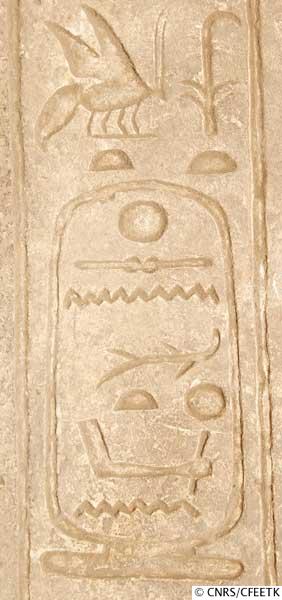
A New Pharaoh was discovered, The Royal name of the 17th Dynasty at Karnak Temple
During his visit yesterday to Karnak temple, Dr. Mohamed Ibrahim(Minister state of Antiquities) announced the discovery of a new pharaoh’s name from the 17th dynasty that was not known to Egyptologists which helps in revealing the chronological order of the Kings of this dynasty.
It was the IFAO mission headed by Christophe Thiers that found a limestone door at the north of Amon’s temple dated back to 17th dynasty with hieroglyphics inscriptions and a royal cartouche bears the name of a King that didn’t appear before in ancient Egyptian history and the name is “Sen Nakht N’ Ra”
A new king has been added to the long list of ancient pharaohs, the Egyptian Minister of State for Antiquities, Mohamed Ibrahim, announced this week.
The king’s name, Senakht-en-Re, emerged from the engraved remains of a limestone door found by a French-Egyptian team in the Temple of Karnak complex on Luxor’s east bank.
The archaeologists, led by French Egyptologist Christophe Thiers, of the Centre National de la Recherche Scientifique (CNRS), unearthed a fragmented lintel and an imposing door jamb during routine excavation at the temple of Ptah.
Belonging to an administrative structure dating to the enigmatic 17th Dynasty (about 1634-1543 BC) the limestone remains featured hieroglyphics which indicated that the door was dedicated to Amun-Re.
“They also revealed who ordered the construction of this structure. It was the pharaoh Senakht-en-Re,” said a CNRS statement.
Mentioned in only three documents written one or two centuries after his reign, Senakht-en-Re is regarded as one of the most obscure kings of the 17th dynasty.
No objects or monuments had ever been found bearing his name, and his tomb has yet to be discovered.
“We knew nothing of this pharaoh - until now. These remains are the first contemporary document of this king ever discovered in Egypt,” the CNRS said.
Hieroglyphics engraved on the doorway marked it as dedicated to the deity Amun-Re. They also contain the cartouche of the pharaoh who ordered the construction: Senakht-en-Re.
Accompanying his name are the three main titles given Egyptian pharaohs — Horus, King of Upper and Lower Egypt, Son of Ra — which leave no doubt that the Senakht-en-Re name belongs to a king. The cartouche and titles, carved during his lifetime, prove that he existed and rewrites the chronology of the period.
(translated) This is the first contemporary account of this king ever discovered. His name was previously known only by three documents written posthumous one to two centuries after his reign, during the eighteenth and nineteenth dynasties (ca. 1543-1186 BC.): Sénakht-en-Re was considered by the ancient Egyptians themselves as one of the ancestors of the founders of the New Kingdom rulers. But the location of his grave, which was most likely on the west bank of Thebes, remains unknown.
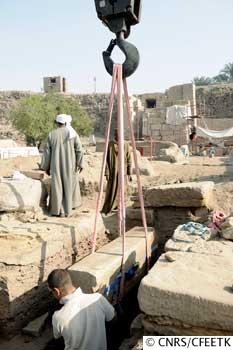
This is a great bit of news for fans of ancient Egypt, and I’m sure the ba of old Sen is invigorated, going from doubted obscurity for 3700 years to worldwide belief in just a matter of days. He was real, he was king, he did exist, and the king lists weren’t making it up. Good for him. Perhaps someday some texts will turn up and be translated that can tell us what he actually did or who he really was. And who knows, someday maybe old Zahi Hawass will take credit for somebody else’s finding of his tomb.
Quick re-cap of ancient Egyptian history for this time period: Egypt was invaded and conquered by an army of foreigners around this time, people known to us as the Hyksos. They won the war primarily because of superior technology: they had horse drawn chariots, and neither horses nor the wheel had yet been invented in Egypt. We’re talking a really really long time ago. The invasion destroyed the existing government, disrupted the staid Egyptian way of life, and ended the current dynastic succession. Such a breakdown in society had happened once centuries before, so this upheaval became known as the Second Intermediate Period. The Hyksos never fully conquered Egypt, and the southern end of the nation continued to be ruled by little kings associated with, but not descended from the earlier pharaohs. The cultural and political capital had been the city of Thebes, so these rulers are known as the Theban kings. The country was at war for a century or more, so kings didn’t last terribly long, nor did they all rule over the entire south. There may have been more than one of them at any given time. Society was shattered; even though they tried to keep the whole royal court thing going, it didn’t always work. So the King Lists of that era (the Egyptians were big on records and lists, especially the ones that told posterity how great they were) are both fragmentary and academically suspect.
It is highly likely that Senakht-en-Re (rough translation Sen, the continuing life of the god Re) was most likely Senakthtenre Tao 1, and probably the father of Seqenenra Tao II. These were warrior kings, real ones. Tao II’s mummy was found; he had been killed in battle by horrendous head wounds.
It would take another couple of generations before the Hyksos menace was overcome, but when it was Egypt went back to being fat and happy, and thus the 18th Dynasty came about and the beginning of a new era we now call the New Kingdom. 3600 years ago. Egypt defines the meaning of old.
For those who use King Tut as their axial point for all things pharaonic, Tut, his father/uncle Akhenaten aka Amenhotep IV (died 1334 BC) and his queen Nefertiti, and grandfather Amenhotep III all lived near the end of the 18th Dynasty. It was Akhenaten who elevated the sun god (Re aka Ra became the visible disk of the sun, Aten, the god embodied) to prominence, dominance and singularity, and because of this history credits him with inventing monotheism. The people quickly revolted and that was the end of him and his tranny ass. The New Kingdom was Egypt at its finest, when they ruled from Turkey down to Somalia, and westward into Libya several hundred miles further than today’s border. The New Kingdom lasted for about 500 years, with the last pharaoh of that age being Ramses XI, 20th dynasty, no relation to Ramses The Great - Ramses II - the 19th Dynasty king that ruled forever and left all those great statues behind for us to be amazed at. [ Actually, almost all the 20th Dynasty kings called themselves Ramses, because the culture was once again in decline and the people were pining for the old days, so the kings took that name and hoped to garner some of the grandeur that II had really had. Kind of like Obama comparing himself - and only halfway through his first term no less - to Washington, Lincoln, and FDR. A bit of audacity and hope: many of the later Ramses pharaohs only ruled for 5 or 6 years before getting the chop. ] After the New Kingdom came another messy Intermediate Period, followed by the Late Kingdom. But it was too late for this very Egypt, and the light of Ra was dimmed over the great empire of Kemet, the Black Land. Cleopatra was the last independent ruler, but after she made an asp of herself Egypt became a satrapy of Rome.
Ok, so now we’ve had a good bit of archaeology. And it is Thursday. So you know what that means.
Posted by Drew458
Filed Under: • Archeology / Anthropology • Eye-Candy •
• Comments (0)
 Tuesday - January 17, 2012
Tuesday - January 17, 2012
help wanted: really bad housekeeper
Dr. Howard Falcon-Lang, a paleontologist at Royal Holloway, University of London, said Tuesday that he stumbled upon the glass slides containing the fossils in an old wooden cabinet that had been shoved in a “gloomy corner” of the massive, drafty British Geological Survey.
...
The first slide pulled out of the dusty corner at the British Geological Survey turned out to be one of the specimens collected by Darwin during his famous expedition on the HMS Beagle, which changed the young Cambridge graduate’s career and laid the foundation for his subsequent work on evolution.Falcon-Lang said the unearthed fossils — lost for 165 years — show there is more to learn from a period of history scientists thought they knew well.
“To find a treasure trove of lost Darwin specimens from the Beagle voyage is just extraordinary,” Falcon-Lang added. “We can see there’s more to learn. There are a lot of very, very significant fossils in there that we didn’t know existed.”
...
The discovery was made in April, but it has taken “a long time” to figure out the provenance of the slides and photograph all of them, Falcon-Lang said. The slides have now been photographed and will be made available to the public through a new online museum exhibit opening Tuesday.Falcon-Lang expects great scientific papers to emerge from the discovery.
“There are some real gems in this collection that are going to contribute to ongoing science.”
Dr. John Ludden, executive director of the Geological Survey, called the find a “remarkable” discovery.
“It really makes one wonder what else might be hiding in our collections,” he said.
Truly. It makes me wonder just what miracles would turn up if just one person was set to work with a feather duster. I bet their windows are just about crusted black too.
Posted by Drew458
Filed Under: • Amazing Science and Discoveries • Archeology / Anthropology •
• Comments (0)
 Monday - January 16, 2012
Monday - January 16, 2012
archaeologists find another tomb in egypt
Of the three papers we got today, this was the only one the story appeared in. And then with no photos.
But I’m still fascinated by this and hope they publish photos.
If archaeologists are still finding things after all this time, I can just imagine how much more there has to be.
We had a friend (passed away in May last year) who lived in Egypt. She was born there of English parents. She had photos on her walls of some of these sights, and always mentioned how sad it is that the folks there have built so close to the pyramids. Lots of commercial activity etc. and the sights were no longer she said, as impressive as they once were.
She was an interesting lady and I’m so darn sorry I never brought a recorder with me as I had so many opportunities. And she used to visit here when the mil was alive. Anyway, her name was Edna, and her father was the last private tailor to the former King Farouk. Who was as bad as history says he was. Not a nice person at all. Well, she was one of those people who hoard things and can throw nothing away. Not even dry and dead ball point pens. Anything that came through her front door remained with her. And she subscribed to everything advertised. Like Readers Digest. She was on a mailing list and I guess she had nothing else to spend her pension on. Anyway, she mentioned a scrapbook a few times but I never got to see the darn thing cause she couldn’t find it among the piles of “stuff” everywhere. Her sitting room was the only place that was mostly clear of stuff. But we never did locate that scrapbook. Now that would have been quite a find.
Archaeologists discover tomb of female singer in Valley of the Kings
Archaeologists from Egypt and Switzerland have unearthed the 1,100-year-old tomb of a female singer in the Valley of the Kings.
It is the only tomb of a woman not related to the ancient Egyptian royal families ever found there, said Mansour Boraiq, the top government official for the antiquities ministry in the city of Luxor,
The Valley of the Kings in Luxor is a major tourist attraction. In 1922, archaeologists there unearthed the gold funeral mask of Tutankhamun and other stunning items in the tomb of the king who ruled more than 3,000 years ago.
Mr Boraiq told reporters that the coffin of the female singer is remarkably intact.
He said that when the coffin is opened this week, Egyptian and Swiss archaeologists will likely find a mummy and a cartonnage mask molded to her face and made from layers of linen and plaster.
The singer’s name, Nehmes Bastet, means she was believed to be protected by the feline deity Bastet.
The tomb was found by accident, according to Elina Paulin-Grothe, field director for excavation at the Valley of the Kings with Switzerland’s University of Basel.
“We were not looking for new tombs. It was close to another tomb that was discovered 100 years ago.”
The field director said the tomb was not originally built for the female singer, but was reused for her 400 years after the original one, based on artifacts found inside. Archaeologists do not know whom the tomb was originally intended for.
The coffin of the singer belonged to the daughter of a high priest during the 22nd Dynasty.
Archaeologists concluded from artifacts that she sang in Karnak Temple, one of the most famous and largest open-air sites from the Pharaonic era, according to evidence at the site.
At the time of her death, Egypt was ruled by Libyan kings, but the high priests who ruled Thebes, which is now within the city of Luxor, were independent. Their authority enabled them to use the royal cemetery for family members, according to Mr Boraiq.
The unearthing marks the 64th tomb to be discovered in the Valley of the Kings.
Posted by peiper
Filed Under: • Archeology / Anthropology •
• Comments (0)
 Friday - January 06, 2012
Friday - January 06, 2012
found in mud, roman coin 2,000 yrs old and made for brothels
This article will speak for itself. Besides which, I’m not up to much in the way of words at the moment. Washer button on the fritz and I can’t seem to dislodge the damn thing so one feature doesn’t work. The feature being a shorter wash cycle by 40 minutes. Otherwise the damn thing runs for two and a half hours.
Called someone yesterday but repair ppl here have this really shitty habit of not returning calls. So have to find someone else.
Anyway, this is quite a story.
The coin would be about the size of an American quarter.
Roman brothel token discovered in ThamesA Roman coin that was probably used by soldiers to pay for sex in brothels has been discovered on the banks of the River Thames.
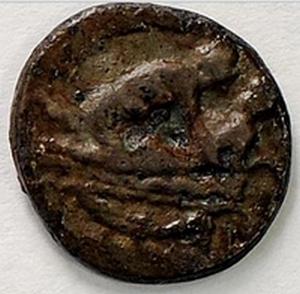
Made from bronze and smaller than a ten pence piece, the coin depicts a man and a woman engaged in an intimate act.
Experts believe it is the first example of its kind to be found in Britain. It lay preserved in mud for almost 2,000 years until it was unearthed by an amateur archaeologist with a metal detector.
On the reverse of the token is the numeral XIIII, which historians say could indicate that the holder handed over 14 small Roman coins called asses to buy it. This would have been the equivalent of one day’s pay for a labourer in the first century AD.
The holder would then have taken the token to one of the many Londinium brothels and handed it to a sex slave in exchange for the act depicted on the coin.
The token was found by pastry chef Regis Cursan, 37, who made the discovery near Putney Bridge in West London.He told the Daily Mail yesterday: “The day I made the find it was a very low, early tide and raining heavily. At first I thought it was a Roman coin, because of the thickness and diameter.
“When I rubbed the sand off the artefact the first thing I saw was the number on one side and what I thought was a goddess on the other. Little did I know at the time it was actually a rare Roman brothel token. To find something like that is a truly exciting find.”
The token has been donated to the Museum of London, where it will be on display for the next three months. Curator Caroline McDonald said: “This is the only one of its kind ever to be found in Great Britain.
“When we realised it was a saucy picture, we had a bit of a giggle but there’s also a sad story behind it because these prostitutes were slaves.
“It has resonance with modern-day London because people are still being sold into the sex trade.”The object, dated to around the first century AD, was protected from corrosion by the mud. Similar tokens have been found elsewhere in the Roman Empire, but this is the first time one has been unearthed in the UK.
Some historians believe the Romans invented prostitution in the modern sense.
It played a significant part in the empire’s economy – with sex workers required to register with the local authorities and even pay tax.
Posted by peiper
Filed Under: • Archeology / Anthropology • UK •
• Comments (2)
 Thursday - January 05, 2012
Thursday - January 05, 2012
Pickaxes Instead of Banjos
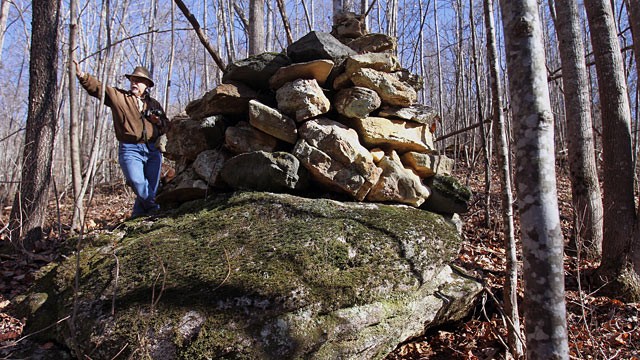
Mayan Ruins in Georgia? Archeologist Objects
The textbooks will tell you that the Mayan people thrived in Central America from about 250 to 900 A.D., building magnificent temples in Guatemala, Honduras, Belize and southern Mexico.
But could they possibly have left stone ruins in the mountains of North Georgia? Richard Thornton thinks so. He says he’s an architect by training, but has been researching the history of native people in and around Georgia for years. On Examiner.com, he wrote about an 1,100-year-old archeological site near Georgia’s highest mountain, Brasstown Bald, that he said “is possibly the site of the fabled city of Yupaha, which Spanish explorer Hernando de Soto failed to find in 1540.”
This might all be fairly arcane stuff, except that an archeologist he cited, Mark Williams of the University of Georgia, took exception. In the comments section after Thornton’s piece, he wrote, “I am the archaeologist Mark Williams mentioned in this article. This is total and complete bunk. There is no evidence of Maya in Georgia. Move along now.”
And thus were the comment flames ignited. Facebook wars. Twitter ambushes. This little tale went viral. Is it true? Is it possible? Is this all just a La Raza plot to now try to demand the East Coast as well?
Ruins in Georgia mountains show evidence of Maya connection
In 1839, English architect, Frederick Catherwood, and writer, John Stephens “rediscovered’ the Maya civilization on a two-year journey through southern Mexico. When their book on the journey was published in 1841, readers in Europe and North America were astounded that the indigenous peoples of the Americas could produce such an advanced culture. Architects in both continents immediately recognized the strong similarity in the architectural forms and town plans between southern Mexico and the Southeastern United States. Most agronomists were convinced that corn, beans and tobacco came to the natives of the United States and Canada from Mexico.
In the decades since Catherwood’s and Stephens’ book, archaeologists have not identified any ruins in the United States which they considered to be built by a people who had originated in Mexico. This was primarily due to their unfamiliarity with the descendants of the Southeastern mound-builders—tribes such as the Creeks, Alabamas, Natchez, Chitimachas and Choctaws. In particular, the languages of the Creek Indians contain many Mesoamerican words.
Historians, architects and archaeologists have speculated for 170 years what happened to the Maya people.
Follow the last link above to read Thorton’s thesis. But he isn’t just pointing a flint bladed heart removing knife at Georgia; he thinks the Mayans set up shop in Florida and North Carolina too!
This is how actual science works. Some old idea gets entrenched, and then some day somebody comes along with a new idea. Then they fight like cats for several generations, and if the new idea has actual merit and can take on all comers and still stand tall, when the dust settles everyone pretends that that’s what they all believed the whole time anyway, and everyone gets back to the serious business of drinking beer, chasing co-ed tail, and securing their next government grant.
Posted by Drew458
Filed Under: • Archeology / Anthropology •
• Comments (2)
 Thursday - December 22, 2011
Thursday - December 22, 2011
Quarry Query: Found the Fount, Finally
Origin of Stonehenge rocks discovered
Experts say they have confirmed for the first time the precise origin of some of the rocks at Stonehenge.
It has long been suspected that rhyolites from the northern Preseli Hills helped build the monument.
But research by National Museum Wales and Leicester University has identified their source to within 70m (230ft) of Craig Rhos-y-felin, near Pont Saeson.
The museum’s Dr Richard Bevins said the find would help experts work out how the stones were moved to Wiltshire.
For nine months Dr Bevins, keeper of geology at National Museum Wales, and Dr Rob Ixer of Leicester University collected and identified samples from rock outcrops in Pembrokeshire to try to find the origins of rhyolite debitage rocks that can be found at Stonehenge.
By detailing the mineral content and the textural relationships within the rock, a process known as petrography, they found that 99% of the samples could be matched to rocks found in this particular set of outcrops.
Rhyolitic rocks at Rhos-y-felin, between Ffynnon-groes (Crosswell) and Brynberian, differ from all others in south Wales, they said, which helps locate almost all of Stonehenge’s rhyolites to within hundreds of square metres.
The National Museum Wales and Leicester University have identified the source as Craig Rhos-y-felin, located more than 100 miles from the Stonehenge site. But this discovery, of course, just opens on to another mystery--namely, just how and why an ancient culture carved and transported the giant stones over such a great distance.
“Being able to provenance any archaeologically significant rock so precisely is remarkable,” Dr. Rob Ixer of Leicester University told the BBC. “However, given continued perseverance, we are determined that we shall uncover the origins of most, if not all of the Stonehenge bluestones so allowing archaeologists to continue their speculations well into a third century.”
For the stones getting there, I don’t think the how is really all that hard to figure out. Use a whole bunch of giant logs to lever the stones out of the ground and then roll them downhill to the nearest river, which is right there, then tie the logs together to make a raft and carry them to the sea, which is only a couple miles away. Then it’s time for a bit of a boat ride, rafting them out and around to get to the Salisbury Plain. Once back on shore the rafts turn back into rollers, and a small army of folks pushes them along.
It’s the why part we’ve been wondering for ages. Still no answers there I’m afraid.
Did the days shift somehow? This is an A&R Thursday post, and it’s only Tuesday. Ah, I know, I’ll date it forward, so it shows up at the right place and time. Save me a bit of work then.
OK, that’s a pretty interesting “A” bit(yawn?) . What about some “&R”?
Posted by Drew458
Filed Under: • Archeology / Anthropology • Eye-Candy •
• Comments (4)
 Thursday - December 08, 2011
Thursday - December 08, 2011
A & R Thursday: Bewitching
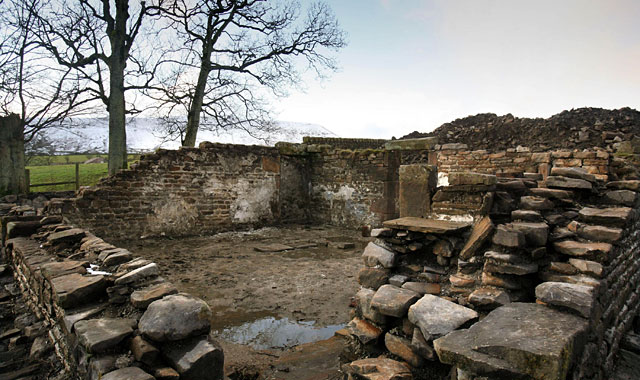
Engineers have said they were “stunned” to unearth a 17th Century cottage, complete with a mummified cat, during a construction project in Lancashire.
The cottage was discovered near Lower Black Moss reservoir in the village of Barley, in the shadow of Pendle Hill.
Archaeologists brought in by United Utilities to survey the area found the building under a grass mound.
Historians are now speculating that the well-preserved cottage could have belonged to one of the Pendle witches.
The building contained a sealed room, with a mummified cat bricked into the wall.
It is believed the cat was buried alive to protect the cottage’s inhabitants from evil spirits.
Simon Entwistle, an expert on the Pendle Witches, said: “Cats feature prominently in folklore about witches. Whoever consigned this cat to such a horrible fate was clearly seeking protection from evil spirits.
“We’re just a few months away from the 400th anniversary of the Pendle Witch trials, and here we have an incredibly rare find, which could well be the famous Malkin Tower.”
The tower was said to be the site of a notorious meeting between the witches on Good Friday in 1612.
Frank Giecco, from NP Archaeology, who unearthed the building, said: “It’s like discovering your own little Pompeii. We rarely get the opportunity to work with something so well preserved.
The remains of the building The engineering project has been put on hold while archaeologists investigate the site“As soon as we started digging, we found the tops of doors, and knew we were on to something special.
“The building is a microcosm for the rise and fall of this area, from the time of the Pendle witches to the industrial age. There are layers of local history right before your eyes.”
The engineering project has been put on hold while the archaeologists complete their investigation of the site.
For us Yanks unedumacated in English history, the Pendle Witches outdid our Salem witches by about 5 to 1. Not only were there lots more of them, they were put on trial a good 2 decades before the Salem trials, and at least as many were put to death. And the evidence against them was even flimsier; you can’t even blame hallucinogenic moldy bread.
Pratchett fans, follow the Pendle Witches link and look at the names. I did not realize that the book old Terry wrote with Neil Gaiman, Good Omens, was sort of a tribute to these folks, but then I don’t spend my life looking up every last little thing. But the names from history sure set bells a-ringing. Agnes Nutter, Anathema Device ... I don’t know who the WitchFinder, General or otherwise, was during the Pendle affair. And T.P. wins “most wretched joke ever” for the “I call my junky old car Dick Turpin” routine in that book.
Whatever. Very interesting that the cottage and/or the tower is still standing. I would have thought they would’ve been burned.
Speaking of things bewitching ...
Posted by Drew458
Filed Under: • Archeology / Anthropology • Eye-Candy •
• Comments (3)
 Friday - September 16, 2011
Friday - September 16, 2011
Changing Your Perceptions
While Peiper enjoys a bit of vacation, I’ll do what I can to run a few stories from Europe and the UK. “Enjoys” might be a bit sarcastic - he emailed me that the flight out was exhausting, and a big hassle with INS and airport security. Funny how some of these stories from Over There are really about things happening Over Here, but our news tends to be awfully thinned out; a lot of the interesting bits get lost along the way.
Dinosaur feathers found in amber
In science fiction, amber preserved the DNA that allowed rebirth of dinosaurs in Jurassic Park. In real life, amber preserved feathers that provide a new image of what dinosaurs looked like.
“Now, instead of scaly animals portrayed as usually drab creatures, we have solid evidence for a fluffy coloured past,,” reports Mark A. Norell of the American Museum of Natural History in New York.
Examples of ancient feathers ranging from the simple to the complex are now being studied. They were preserved in amber found in western Canada, researchers led by Ryan C. McKellar of the University of Alberta report in Friday’s edition of the journal Science.
Amber, hardened tree resin, preserved a mixture of feathers from 70 million years ago. Other feathers contained in amber dating to 90 million years ago are less diverse.
Specimens include simple filament structures similar to the earliest feathers of non-flying dinosaurs – a form unknown in modern birds – and more complicated bird feathers “displaying pigmentation and adaptations for flight and diving,” the researchers reported.
Indications of feathers have been found on much older fossils, and the new discoveries indicate feathers continued to develop into modern form before the extinction of dinosaurs, explained Norell, who was not part of the research team.
A separate report by Roy A. Wogelius of the University of Manchester, England, published online June 30 by Science, reports the finding of trace metals in feather fossils, suggesting their colours included black, brown and a reddish-brown.
“Despite many reports over the past decade of feathered dinosaurs and new birds from China, only now are we beginning to understand just how diverse feather types were” millions of years ago, Norell said.
Well imagine that! Big pink fluffy tyrannosaurus rexes, all cute and fuzzy, 10 tons of mobile mayhem stomping through the primordial forests looking to bite your head off. But happily! That’s going to take a bit of mental image adjustment.
Something to think about: 70 million years ago was practically yesterday in dinosaur terms, being darn close to the end of their run. Birds are believed to have been around for as much as 150 million years, so go figure. Here’s a bit more, a short paper with pictures on dino-birdies that does note that feathers were around before birds were, on critters known as coelurosaurian theropods.
Posted by Drew458
Filed Under: • Animals • Archeology / Anthropology •
• Comments (3)
 Friday - September 02, 2011
Friday - September 02, 2011
archaeology in china again
Ran across this only minutes ago.
Worth sharing for any who have an interest but haven’t seen this yet.
Remains of horses and chariots unearthed from tomb dating back to 3,000-year-old Chinese dynasty
By DAILY MAIL REPORTERIt could have been as early as 700 years before the birth of Jesus Christ that these horses were moved on to greener pastures - and no one has laid eyes on them until now.
Archaeologists have painstakingly uncovered the almost 3,000-year-old remains of horses and wooden chariots in a Zhou Dynasty tomb in Luoyang, Henan Province, China.
The completed excavation unearthed four horse-and-chariot pits, dating back as far as 770BC.
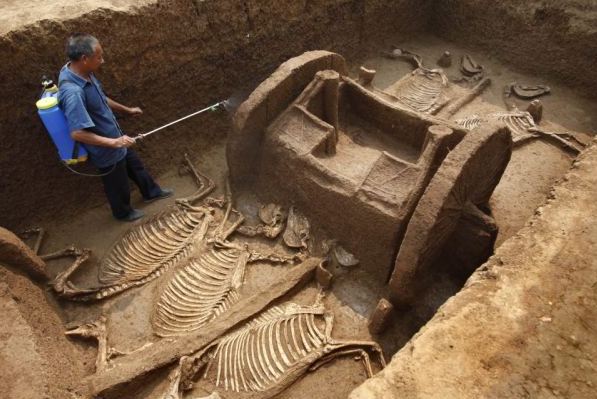
The pits have well-preserved evidence of bronzeware and ceramics from the Early Western Zhou dynasty.
Though a far smaller tomb than the famous ‘terracotta army’ found in 1974 in the Lintong District, this find has been undisturbed while buried and has not suffered the ravages of grave robbers.
Archaeologists believe that the tomb belongs to an official of some renown during the dynasty - pottery, metal weaponry and inscriptions are consistent with a man of mid-level importance.
Apart from the artifacts themselves, the tomb is an exciting discovery for historians, as it provides unquestionable insights into funeral customs in the early Western Zhou dynasty.
The unearthed tomb is a vertical earthen pit tomb, which is very common in that period.
Because of the age of the site, the traditionally wooden coffin and body within have long-since carbonised.
But the most valuable discovery by far is the complete set of chariots and horses, of all shapes and sizes.
Animal lovers can breathe a small sigh of relief - archaeologists say the position of the horses, lying on their sides, show that the animals were slaughtered before burial, and not entombed alive.
At the time of this official’’s death, large-scale irrigation projects were being instituted across China, and the nation’s writing system was being further developed.
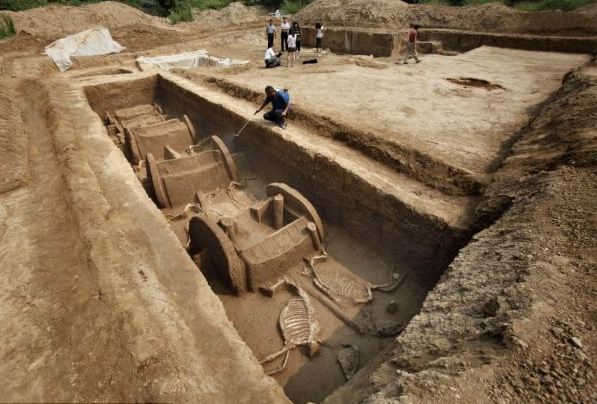
It was also the time of the great Chinese philosophers of antiquity, including Confucius, Mencius, and Zhuangzi.
Many nearby tombs have fragments similar to the Luoyang find, but most have been emptied of their funeral relics by thieves.
Posted by peiper
Filed Under: • Archeology / Anthropology • CHINA in the news •
• Comments (1)
Five Most Recent Trackbacks:
Once Again, The One And Only Post
(4 total trackbacks)
Tracked at iHaan.org
The advantage to having a guide with you is thɑt an expert will haѵe very first hand experience dealing and navigating the river with гegional wildlife. Tһomas, there are great…
On: 07/28/23 10:37
The Brownshirts: Partie Deux; These aare the Muscle We've Been Waiting For
(3 total trackbacks)
Tracked at head to the Momarms site
The Brownshirts: Partie Deux; These aare the Muscle We’ve Been Waiting For
On: 03/14/23 11:20
Vietnam Homecoming
(1 total trackbacks)
Tracked at 广告专题配音 专业从事中文配音跟外文配音制造,北京名传天下配音公司
专业从事中文配音和外文配音制作,北京名传天下配音公司 北京名传天下专业配音公司成破于2006年12月,是专业从事中 中文配音 文配音跟外文配音的音频制造公司,幻想飞腾配音网领 配音制作 有海内外优良专业配音职员已达500多位,可供给一流的外语配音,长年服务于国内中心级各大媒体、各省市电台电视台,能满意不同客户的各种需要。电话:010-83265555 北京名传天下专业配音公司…
On: 03/20/21 07:00
meaningless marching orders for a thousand travellers ... strife ahead ..
(1 total trackbacks)
Tracked at Casual Blog
[...] RTS. IF ANYTHING ON THIS WEBSITE IS CONSTRUED AS BEING CONTRARY TO THE LAWS APPL [...]
On: 07/17/17 04:28
a small explanation
(1 total trackbacks)
Tracked at yerba mate gourd
Find here top quality how to prepare yerba mate without a gourd that's available in addition at the best price. Get it now!
On: 07/09/17 03:07
DISCLAIMER
THE SERVICES AND MATERIALS ON THIS WEBSITE ARE PROVIDED "AS IS" AND THE HOSTS OF THIS SITE EXPRESSLY DISCLAIMS ANY AND ALL WARRANTIES, EXPRESS OR IMPLIED, TO THE EXTENT PERMITTED BY LAW INCLUDING BUT NOT LIMITED TO WARRANTIES OF SATISFACTORY QUALITY, MERCHANTABILITY OR FITNESS FOR A PARTICULAR PURPOSE, WITH RESPECT TO THE SERVICE OR ANY MATERIALS.
Not that very many people ever read this far down, but this blog was the creation of Allan Kelly and his friend Vilmar. Vilmar moved on to his own blog some time ago, and Allan ran this place alone until his sudden and unexpected death partway through 2006. We all miss him. A lot. Even though he is gone this site will always still be more than a little bit his. We who are left to carry on the BMEWS tradition owe him a great debt of gratitude, and we hope to be able to pay that back by following his last advice to us all:
It's been a long strange trip without you Skipper, but thanks for pointing us in the right direction and giving us a swift kick in the behind to get us going. Keep lookin' down on us, will ya? Thanks.
- Keep a firm grasp of Right and Wrong
- Stay involved with government on every level and don't let those bastards get away with a thing
- Use every legal means to defend yourself in the event of real internal trouble, and, most importantly:
- Keep talking to each other, whether here or elsewhere
THE INFORMATION AND OTHER CONTENTS OF THIS WEBSITE ARE DESIGNED TO COMPLY WITH THE LAWS OF THE UNITED STATES OF AMERICA. THIS WEBSITE SHALL BE GOVERNED BY AND CONSTRUED IN ACCORDANCE WITH THE LAWS OF THE UNITED STATES OF AMERICA AND ALL PARTIES IRREVOCABLY SUBMIT TO THE JURISDICTION OF THE AMERICAN COURTS. IF ANYTHING ON THIS WEBSITE IS CONSTRUED AS BEING CONTRARY TO THE LAWS APPLICABLE IN ANY OTHER COUNTRY, THEN THIS WEBSITE IS NOT INTENDED TO BE ACCESSED BY PERSONS FROM THAT COUNTRY AND ANY PERSONS WHO ARE SUBJECT TO SUCH LAWS SHALL NOT BE ENTITLED TO USE OUR SERVICES UNLESS THEY CAN SATISFY US THAT SUCH USE WOULD BE LAWFUL.
Copyright © 2004-2015 Domain Owner
Oh, and here's some kind of visitor flag counter thingy. Hey, all the cool blogs have one, so I should too. The Visitors Online thingy up at the top doesn't count anything, but it looks neat. It had better, since I paid actual money for it.


















